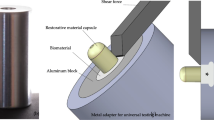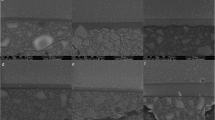Abstract
Background
The clinical success of large class II resin-modified glass-ionomer cement/composite resin (RMGIC/CR) ‘open-sandwich’ restorations in permanent or primary molars may be influenced by certain bonding parameters.
Aim
To examine in vitro the effect of placing/curing mode on the RMGIC/CR bond strength.
Design
Two restoratives, a CR (Z250), a RMGIC (Vitremer) and a bonding agent (Adper Single Bond 2), all of 3M ESPE, were used for preparing five groups of seven specimen sticks each. The bond between the two restorative materials at the stick centre was created in the three test groups by: (A) 1-step placing RMGIC in contact with CR, then photocuring; (B) 2-step RMGIC placing/curing, then CR placement/curing; (C) 3-step RMGIC placing/curing, bonding agent placing/curing, CR placing/curing. Control groups consisted of sticks made of CR alone (D, positive) and RMGIC alone (E, negative). The specimens were subjected to tensile stress measurements in an Instron dynamometer and examined by scanning electron microscope for type of failure.
Statistics
Tensile bond strength, tensile strain and elastic modulus differences were examined with one-way ANOVA and Tukey test.
Results
Among experimental groups, Group C exhibited significantly higher tensile strength (MPa) means (A = 12.11 ± 4.72, B = 15.69 ± 5.18, C = 19.08 ± 4.05) and significantly higher tensile strain (%) means (A = 0.50 ± 0.11, B = 0.64 ± 0.19, C = 0.98 ± 0.24), compared to Group A, at p = 0.05. Group D had significantly higher tensile strength and strain than all other groups. No statistically significant differences were observed in the elastic modulus. The use of bonding agent (Group C) resulted in absence of adhesive failures as seen by SEM.
Conclusion
The use of bonding agent improved the CR/RMGIC bond by tensile strength and strain tests.




Similar content being viewed by others
References
Andersson-Wenckert IE, van Dijken JW, Kieri C. Durability of extensive Class II open-sandwich restorations with a resin-modified glass ionomer cement after 6 years. Am J Dent. 2004;17:43–50.
Atieh M. Stainless steel crown versus modified open-sandwich restorations for primary molars: a 2-year randomized clinical trial. Int J Paediatr Dent. 2008;18:325–32.
Bottenberg P, Jacquet W, Alaerts M, Keulemans F. A prospective randomized clinical trial of one bis-GMA-based and two ormocer-based composite restorative systems in class II cavities: five-year results. J Dent. 2009;37:198–203.
Chadwick RG, Woolford MJ. A comparison of the shear bond strengths to a resin composite of two conventional and two resin-modified glass polyalkenoate (ionomer) cements. J Dent. 1993;21:111–6.
Chadwick BL, Evans DJ. Restoration of class II cavities in primary molar teeth with conventional and resin modified glass ionomer cements: a systematic review of the literature. Eur Arch Paediatr Dent. 2007;8:14–21.
Costa CA, Ribeiro AP, Giro EM, et al. Pulp response after application of two resin modified glass ionomer cements (RMGICs) in deep cavities of prepared human teeth. Dent Mater. 2011;27:158–70.
Donly JK, Sequra A, Kanellis M, Erickson RL. Clinical performance and caries inhibition of resin-modified glass ionomer cement and amalgam restorations. JADA. 1999;130:1459–65.
Farah CS, Orton VG, Collard SM. Shear bond strength of chemical and light-cured glass ionomer cements bonded to resin composites. Aust Dent J. 1998;43:81–6.
Forss H, Widström E. The post-amalgam era: a selection of materials and their longevity in the primary and young permanent dentitions. Int J Pediatr Dent. 2003;13:158–64.
Ilie N, Hickel R, Watts DC. Spatial and cure-time distribution of dynamic-mechanical properties of a dimethacrylate nano-composite. Dent Mater. 2009;25:411–8.
Kerby RE, Knobloch L. The relative shear bond strength of visible light-curing and chemically curing glass-ionomer cement to composite resin. Quintessence Int. 1992;23:641–4.
Kotsanos N, Arizos S. Evaluation of a resin modified glass ionomer serving both as indirect pulp therapy and as restorative material for primary molars. Eur Arch Paediatr Dent. 2011;12:170–5.
Koubi S, Raskin A, Dejou J, et al. Effect of dual cure composite as dentine substitute on the marginal integrity of Class II open-sandwich restorations. Oper Dent. 2010;35:165–71.
Levin L, Coval M, Geiger SB. Cross-sectional radiographic survey of amalgam and resin-based composite posterior restorations. Quintessence Int. 2007;38:511–4.
Li J, Liu Y, Liu Y, et al. Flexure strength of resin-modified glass ionomer cements and their bond strength to dental composites. Acta Odontol Scand. 1996;54:55–8.
Mount GJ. The tensile strength of the union between various glass ionomer cements and various composite resins. Aust Dent J. 1989;34:136–46.
Navimipour EJ, Oskoee SS, Oskoee PA, et al. Effect of acid and laser etching on shear bond strength of conventional and resin-modified glass-ionomer cement to composite resin. Lasers Med Sci. 2012;27:305–11.
Oilo G, Um CM. Bond strength of glass-ionomer cement and composite resin combinations. Quintessence Int. 1992;23:633–9.
Oilo G. Bond strength testing–what does it mean? Int Dent J. 1993;43:492–8.
Qvist V, Poulsen A, Teglers PT, et al. The longevity of different restorations in primary teeth. Int J Paediatr Dent. 2010;20:1–7.
Rathore M, Singh A, Pant VA. The dental amalgam toxicity fear: a myth or actuality. Toxicol Int. 2012;19(2):81–8.
Salz U, Bock T. Testing adhesion of direct restoratives to dental hard tissue—a review. J Adhes Dent. 2010;12:343–71.
Sidhu SK. Clinical evaluations of resin-modified glass-ionomer restorations. Dent Mater. 2010;26:7–12.
Taher NM, Ateyah NZ. Shear bond strength of resin modified glass ionomer cement bonded to different tooth-colored restorative materials. J Contemp Dent Pract. 2007;8:25–34.
van Dijken JW, Kieri C, Carlén M. Longevity of extensive class II open-sandwich restorations with a resin-modified glass-ionomer cement. J Dent Res. 1999;78:1319–25.
Vilkinis V, Hörsted-Bindslev P, Baelum V. Two-year evaluation of Class II resin-modified glass ionomer cement/composite open sandwich and composite restorations. Clin Oral Invest. 2000;4:133–9.
Wexler G, Beech DR. Bonding of a composite restorative material to etched glass ionomer cement. Aust Dent J. 1988;33:313–8.
Yengopal V, Harneker SY, Patel N, Siegfried N. Dental fillings for the treatment of caries in the primary dentition. Cochrane Database Syst Rev. 2009;15(2):CD004483.
Yengopal V, Mickenautsch S. Caries-preventive effect of resin-modified glass-ionomer cement (RM-GIC) versus composite resin: a quantitative systematic review. Eur Arch Paediatr Dent. 2011;12:5–14.
Zimmerman JA, Feigal RJ, Till MJ, Hodges JS. Parental attitudes on restorative materials as factors influencing current use in pediatric dentistry. Pediatr Dent. 2009;31:63.
Acknowledgments
3M ESPE is thanked for kindly supplying the materials used in the study.
Author information
Authors and Affiliations
Corresponding author
Rights and permissions
About this article
Cite this article
Fragkou, S., Nikolaidis, A., Tsiantou, D. et al. Tensile bond characteristics between composite resin and resin-modified glass-ionomer restoratives used in the open-sandwich technique. Eur Arch Paediatr Dent 14, 239–245 (2013). https://doi.org/10.1007/s40368-013-0055-2
Received:
Accepted:
Published:
Issue Date:
DOI: https://doi.org/10.1007/s40368-013-0055-2




